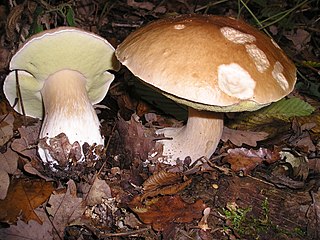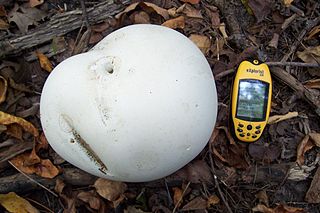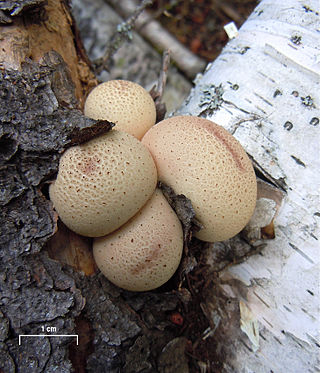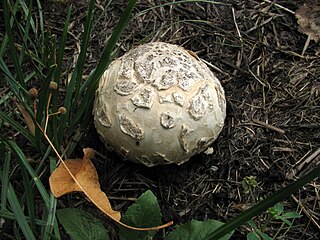
Puffballs are a type of fungus featuring a ball-shaped fruit body that bursts on contact or impact, releasing a cloud of dust-like spores into the surrounding area. Puffballs belong to the division Basidiomycota and encompass several genera, including Calvatia, Calbovista and Lycoperdon. The puffballs were previously treated as a taxonomic group called the Gasteromycetes or Gasteromycetidae, but they are now known to be a polyphyletic assemblage.

Edible mushrooms are the fleshy fruit bodies of several species of macrofungi. Edibility may be defined by criteria including the absence of poisonous effects on humans and desirable taste and aroma. Mushrooms that have a particularly desirable taste are described as "choice". Edible mushrooms are consumed for their nutritional and culinary value. Mushrooms, especially dried shiitake, are sources of umami flavor.

The Boletales are an order of Agaricomycetes containing over 1300 species with a diverse array of fruiting body types. The boletes are the best known members of this group, and until recently, the Boletales were thought to only contain boletes. The Boletales are now known to contain distinct groups of agarics, puffballs, and other fruiting-body types.

A bolete is a type of mushroom, or fungal fruiting body. It can be identified thanks to a unique cap. On the underside of the cap there is usually a spongy surface with pores, instead of the gills typical of mushrooms. A similar pore surface is found in polypores, but these species generally have a different physical structure from boletes, and have different microscopic characteristics than boletes. Many polypores have much firmer, often woody, flesh.

Scleroderma citrinum, commonly known as the common earthball, pigskin poison puffball, or common earth ball, is a species of earthball fungus found in Europe and in North America. It is the most common species of earthball fungus in the UK and occurs widely in woods, heathland and in short grass from autumn to winter. Scleroderma citrinum has two synonyms, Scleroderma aurantium (Vaill.) and Scleroderma vulgare Horn.

Calvatia gigantea, commonly known in English as the giant puffball, is a puffball mushroom commonly found in meadows, fields, and deciduous forests in late summer and autumn. It is found in temperate areas throughout the world.

Lycoperdon perlatum, popularly known as the common puffball, warted puffball, gem-studded puffball or devil's snuff-box, is a species of puffball fungus in the family Agaricaceae. A widespread species with a cosmopolitan distribution, it is a medium-sized puffball with a round fruit body tapering to a wide stalk, and dimensions of 1.5 to 6 cm wide by 3 to 10 cm tall. It is off-white with a top covered in short spiny bumps or "jewels", which are easily rubbed off to leave a netlike pattern on the surface. When mature it becomes brown, and a hole in the top opens to release spores in a burst when the body is compressed by touch or falling raindrops.

Scleroderma cepa, commonly known as the smooth earthball or onion earthball, is an ectomycorrhizal fungus used as a soil inoculant in agriculture and horticulture. It is poisonous.

Calvatia booniana, commonly known as the western giant puffball, is a puffball mushroom that can grow 10 to 70 centimetres in diameter, as large as its close relative, the giant puffball of eastern North America and Europe. Like the giant puffball, it grows on composted soil such as in meadows, fields, and forests, as well as on roadsides, sagebrush flats, pastures, and other sunny places. In general, western giant puffballs occur on the west side of the Rockies and giant puffballs occur on the east side. However, on the West Coast of North America the western giant puffball is replaced by the giant puffball or a closely related species.

The Sclerodermataceae are a family of fungi in the order Boletales, containing several genera of unusual fungi that little resemble boletes. Taxa, which include species commonly known as the ‘hard-skinned puffballs’, ‘earthballs’, or 'earthstars', are widespread in both temperate and tropical regions. The best known members include the earthball Scleroderma citrinum, the dye fungus Pisolithus tinctorius and the 'prettymouths' of the genus Calostoma.

Apioperdon pyriforme commonly known as the pear-shaped puffball or stump puffball, is a saprobic fungus present throughout much of the world. Emerging in autumn, this puffball is common and abundant on decaying logs of both deciduous and coniferous wood. It is considered a choice edible when still immature and the inner flesh is white. It is often called Lycoperdon pyriforme, but was transferred to Apioperdon in 2017 based on phylogenetic and morphological differences. It is the only species in the genus.

Podaxis pistillaris is a very distinctive relative of the puffballs. It is commonly known as the desert shaggy mane, as it bears a superficial resemblance to the shaggy mane, Coprinus comatus; this species lacks the latter's deliquescing gills, however, and the two are not closely related. It grows to 15 cm high and has a hard, woody stem. The large cap, which protects the blackish spore-bearing tissue, splits, and usually falls away at maturity, allowing the spores to be dispersed by wind. Large numbers may appear after soaking rains. It thrives in deserts and semi-deserts of Australia and other countries, often found on termite mounds in South Africa. In the Hawaiian Islands, it is frequently encountered along roadsides and in disturbed areas on the dry sides of the islands, especially in the Kona area of Hawaii and the Kihei area of Maui.

Calvatia sculpta, commonly known as the sculpted puffball, the sculptured puffball, the pyramid puffball, or Sierran puffball, is a species of puffball fungus in the family Agaricaceae. Attaining dimensions of up to 8 to 15 cm tall by 8 to 10 cm wide, the pear- or egg-shaped puffball is readily recognizable because of the large pyramidal or polygonal warts covering its surface. It is edible when young, before the spores inside the fruit body disintegrate into a brownish powder. The spores are roughly spherical, and have wart-like projections on their surfaces.

Calbovista is a fungal genus containing the single species Calbovista subsculpta, commonly known as the sculptured puffball, sculptured giant puffball, and warted giant puffball. It is a common puffball of the Rocky Mountains and Pacific Coast ranges of western North America. The puffball is more or less round with a diameter of up to 15 cm (6 in), white becoming brownish in age, and covered with shallow pyramid-shaped plates or scales. It fruits singly or in groups along roads and in open woods at high elevations, from summer to autumn.

Mycenastrum is a fungal genus in the family Agaricaceae. The genus is monotypic, containing one widely distributed species, Mycenastrum corium, known by various common names: the giant pasture puffball, leathery puffball, or tough puffball. The roughly spherical to turnip-shaped puffball-like fruit bodies grow to a diameter of 6–24 cm (2–9 in). Initially covered by a thick, felted, whitish layer, the puffballs develop a characteristic checkered skin (peridium) in age. When the internal spore mass, the gleba, is firm and white, the puffball is edible, although some individuals may suffer mild gastrointestinal symptoms after eating it. As the spores mature, the gleba turns first yellowish then purplish brown. Spores are released when the peridium eventually splits open into irregularly shaped sections. Microscopically, the gleba consists of spherical, dark brown spores with rounded bumps on their surfaces, and a capillitium—intricately branched fibers that form long thorn-like spines. The puffball grows on or in the ground in prairie or desert habitats. Although widely distributed, it is not commonly encountered. Mycenastrum corium is a threatened species in Europe.

The gasteroid fungi are a group of fungi in the Basidiomycota. Species were formerly placed in the obsolete class Gasteromycetes Fr., or the equally obsolete order Gasteromycetales Rea, because they produce spores inside their basidiocarps rather than on an outer surface. However, the class is polyphyletic, as such species—which include puffballs, earthballs, earthstars, stinkhorns, bird's nest fungi, and false truffles—are not closely related to each other. Because they are often studied as a group, it has been convenient to retain the informal (non-taxonomic) name of "gasteroid fungi".

Scleroderma polyrhizum, commonly known as the star earthball or dead man's hand, is a basidiomycete fungus and a member of the genus Scleroderma, or "earthballs". Found in dry, sandy soils, this species begins completely buried before slowly forcing the soil aside as it cracks apart to form a rough, star-shaped body with a diameter of 12–15 cm (4.7–5.9 in). At the center is the dark, brownish spore mass. Widely distributed wherever the soil and climate are favorable, it is known from Asia, Europe, and the Americas.

Calostoma cinnabarinum, commonly known as the stalked puffball-in-aspic,gelatinous stalked-puffball, or red slimy-stalked puffball, is a species of gasteroid fungus in the family Sclerodermataceae, and is the type species of the genus Calostoma. The fruit body has a distinctive color and overall appearance, featuring a layer of yellowish jelly surrounding a bright red, spherical head approximately 2 centimeters (0.8 in) in diameter atop a red or yellowish brown spongy stipe 1.5 to 4 cm tall. The innermost layer of the head is the gleba, containing clear or slightly yellowish elliptical spores, measuring 14–20 micrometers (μm) long by 6–9 μm across. The spore surface features a pattern of small pits, producing a net-like appearance. A widely distributed species, it grows naturally in eastern North America, Central America, northeastern South America, and East Asia. C. cinnabarinum grows on the ground in deciduous forests, where it forms mycorrhizal associations with oaks.

Scleroderma meridionale is a puffball-like fungus in the family Sclerodermataceae. It was originally described in 1970 from Portugal, but is also found in North America. The fungus has a roughly circular to irregularly shaped fruit body up to 6 cm (2.4 in) in diameter with a thick, rooting base. The peridium is up to 2 mm thick and has a dry, roughened surface colored tan to yellow. Mature fruit bodies tend to split into irregular lobes, revealing a dark brownish- to blackish-gray spore mass (gleba). The spores are spherical with small spikes and measure 12–20 μm. Scleroderma meridionale grows in sandy areas, where it fruits singly or scattered in a partially buried state. Its edibility is unknown.

Bovista pila, commonly known as the tumbling puffball, is a species of puffball fungus in the family Agaricaceae. A temperate species, it is widely distributed in North America, where it grows on the ground on road sides, in pastures, grassy areas, and open woods. There are few well-documented occurrences of B. pila outside North America. B. pila closely resembles the European B. nigrescens, from which it can be reliably distinguished only by microscopic characteristics.



















